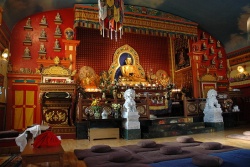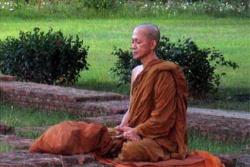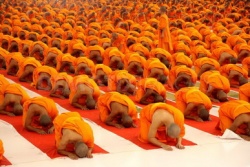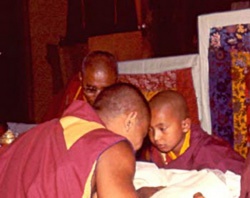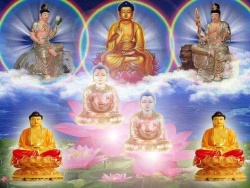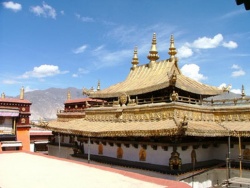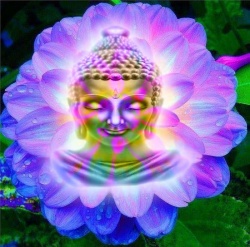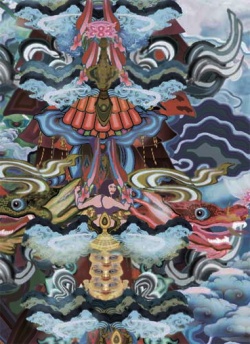Kalapa.
Shambhala tradition says that Kalapa was the capital of the Kingdom of Shambhala. We know how important that was to the Druk Sakyong and to the Shambhala terma he gave us.
The Druk Sakyong also gave the name Kalapa Court to his residence in Boulder to signify that it was the center of the mandala of the Vajradhatu organization.
He also gave the name to a remote and beautiful valley in Cape Breton, Nova Scotia — Kalapa Valley, which was later identified by Eva Wong as the energetic center of the entire Shambhala mandala.
Kalapa is now also the name of a nonprofit corporation registered in its articles of incorporation as a “church of the Sakyong lineage” in Colorado in 2007.
The original registration was in the name of Kalapa Court, but in 2007 the name change occurred. Since it was turned into a legal entity, Kalapa has acquired new meanings. The Sakyong spelled these out, to some extent, in his Shambhala Day address in February, 2008:
In thinking about the notion of lineage — who we are — I have created a new format, a structure that I’m calling Kalapa.
Kalapa will be the storehouse and protector of the Shambhala lineage, and in particular, the lineage of Sakyongs. … I do not hold it lightly, as it’s obviously both a blessing and a burden. …
The notion of the lineage of Sakyongs has to continue. It’s the source of spiritual blessing and teaching. It felt important in terms of all the teachings and the artifacts of the Vidyadhara, as well as those that I am continuing to produce, that all those will be safeguarded in Kalapa.
The Sakyong’s vision for Kalapa was later described by President Reoch[1] as:
the structure for the Sakyong to express his direct command and wishes; ensure the preservation of the lineage and teachings of the Sakyongs; provide the container for the lineage succession, seals, texts and properties of the Sakyongs; and disseminate and govern.
From an inner perspective, if by Kalapa we mean the center of Shambhala, it can’t be preserved or protected legally because a mandala is not an entity that is recognized by the laws of the United States. Neither can spiritual lineages or the buddhadharma or the Shambhala teachings be protected by legal means.
What Kalapa, the nonprofit corporation, is meant to protect according to the Sakyong’s “wish and command“ is tangible things, such as terma texts, copyrights, practice implements, and quite possibly also property — in particular, the Great Stupa of Dharmakaya and Kalapa Valley.
What, exactly, does it mean when the Sakyong says that the purpose of Kalapa is to be the storehouse and protector of the Shambhala lineage, and in particular, the lineage of Sakyongs?
I had hoped that a careful reading of minutes from recent Sakyong Council meetings would shed light on my questions. Minutes of these meetings are available to dues-paying members on the Shambhala International website. However, what I read left me more puzzled than informed. First, from the May 22 meeting:
Confusion was expressed around the category of items on the wish list which were labeled as “Lineage items” and which would be receiving funding from “Kalapa patrons”.
Connie [Brock] was asked to explain the relationship between the Shambhala budget/funding and these other expenses/funding.
Connie explained that the current process of establishing financial priorities and budget for Shambhala was happening alongside a process of considering a budget for the newly forming “Kalapa”. [some words seem to have been omitted here]
The process [is?] underway [words missing] Kalapa is currently trying to determine which of the Sakyong’s expenses would belong in which category (personal, official).
Finance and legal affairs would meet to consider the draft legal document for Kalapa and the draft budget for Kalapa in the near future.
Connie clarified that the two budgets — Shambhala and Kalapa — would remain separate and would be reported separately. … Kalapa will have its own funding sources … The Sakyong had himself determined the prioritization of the Lineage items.
In case readers are confused by the meaning and possible consequences of these minutes, I am just as confused as you might be.
There is more on the subject in the minutes for the following meeting (June 5, 2008):
Further clarification was requested on the items on the list [the wish list referred to earlier in the minutes] which were indicated to be funded by “Kalapa Patrons.”
Connie [Brock] explained that these were items which would not need to be funded through the Shambhala budget, because there were patrons of Kalapa who had pledged money or who would be asked to pledge to fund these items.
She clarified that those items listed in the Kalapa Budget were not being put forward for approval by the Sakyong’s Council, because they were the responsibility of the Sakyong and the Kalapa Budget.
However, those items funded by Kalapa Patrons and listed under the Shambhala Budget would require consideration and approval by the Sakyong’s Council (such as the Executive Director position).
In an e-mail on 2008/9/27 I asked Terry Rudderham about some questions that arose from reading these minutes. I have rearranged our e-mails so that Terry’s responses follow my questions.
Question: I read the minutes of the Sakyong’s Council meeting on June 5, this year. You were “there,” in phone space [meetings are accomplished by conference calls]. Can you tell me:
1. What are Kalapa Patrons?
Terry: Kalapa Patrons are sangha donors that take an oath to actively embrace generosity as their path of practice, and commit to making large monetary gifts whenever possible.
Often times, but not always, these are gifts that support the activities of the Sakyong. i.e. A patron may pay for Rinpoche to go on a retreat in India if there are not sufficient funds in the Shambhala budget to support this activity.
2. What is the Kalapa Budget?
Terry: When the organization Kalapa is formed, it will have a budget. Much of the funding for that budget will come from Kalapa Patrons.
3. How do each of these relate to the budget of Core Services and Sakyong Support?
Terry: At this point it is still being contemplated what elements will be covered by the Kalapa Budget.
What are currently known as Core Services will likely remain the same, covering the Shambhala Office of Practice and Education, the Shambhala Office of Finance and Development and similar functions that provide support services to the Shambhala Centres and members. Some aspects of the current budget for Sakyong Support would likely be reclassified as part of the Kalapa Budget, but this is still being contemplated and worked on.
Kalapa has a board called the Kalapa Council and they will have the responsibility of making decisions for Kalapa.
The Sakyong’s Council is the board for Shambhala and their decision making will be focused on Shambhala.
While they will not be involved in the day-to-day matters of Kalapa, they will be involved in matters that interrelate.
After reading Terry Rudderham’s e-mail, I contacted Connie Brock to ask for an interview, which she graciously gave. Connie is Chagdzo Kyi Khyap, which means Bursar General.
Connie explained:
“The Sakyong asked me to serve as a coordinator of finances across his mandala.
There’s a function loosely referred to as the Treasury, which includes all the entities at the inner court level, and it also includes the new entities you referred to (Kalapa, the Sakyong Foundation, and the Kalapa Group].”
Connie Brock is a key person in the mandala.
In addition to sitting on the Sakyong’s Council and the recently formed Kalapa Council, she is a board member of the Sakyong Foundation, a core member of the Shambhala Trust (a separate organization), and the Finance Director of the Minneapolis Shambhala Center.
The following are portions of my interview with Connie Brock.
Question: What is the role of the Kalapa Council?
Connie: Part of our responsibility is to work through exactly what all this means, how Kalapa should be legally set up to take the Sakyong’s idea of Kalapa forward. So we’re working with that over the next couple of months, and hopefully by the end of the year we’ll have a clear recommendation for the Sakyong about how to move forward.
Q: In terms of governance, will Kalapa and the Sakyong’s Council be at a level that could be described as parallel and equal? Or will one have a higher authority than the other?
Connie: I think from a governance point of view the way we’ve been describing it is more like nested oryoki bowls.
You have the Sakyong as the inner bowl, then you have the Kalapa Council, and the next bowl is the Sakyong’s Council, and the next bowl is the Mandala Council.
And then you have the Congresses. And they’re nested in the sense that every member of the [[Kalapa Council\\ is on the Sakyong’s Council, and every member of the Sakyong’s Council is on the Mandala Council.
Each bowl is bigger, but each bowl contains the previous one.
The value of that is that it creates integration, and it probably looks more like a mandala than what we might think of as traditional organizational structures.
Q: So it’s not a question of hierarchy?
Connie: No, I don’t think so. It’s a matter of each bowl having its purpose.
So, for example, the kinds of questions that Kalapa Council looks at are ones that are beyond the scope of the Sakyong’s Council, typically because the Kalapa Council crosses church, state and military (Kasung).
Q: On Shambhala Day, the Sakyong said that “it felt important in terms of all the teachings and the artifacts of the Vidyadhara, as well as those that I am continuing to produce, that all those will be safeguarded in Kalapa.”
What, exactly, will Kalapa contain and protect? Would it include Kalapa Valley and the Great Stupa of Dharmakaya?
Connie: Whether or not it makes sense to put property in Kalapa is still very much an open question. But what is quite clear is this notion of maintaining what you might call the key lineage assets: the terma, the copyrights, et cetera, as well as the ritual objects.
Part of this arose out of the fact that, when the Vidyadhara died, there had been no legal arrangements for any of this, so much of the copyrights went to Lady Diana, because she was his widow.
And obviously the intent is that these be carried by the lineage.
President Reoch spoke about that: that Lady Diana very much supports this idea, and does want to be able to transfer the copyrights to Kalapa as a lineage institution, so that they are carried from Sakyong to Sakyong. So that’s obviously a very key point.
Because we’re considering the possibility of transferring assets, like Kalapa Valley or the Stupa, then there are a couple of ways you could structure things legally.
For example, you can set up a trust to hold properties, or it could be through Kalapa as a church.
Those questions are still open.
It’s a bit complicated legally because whatever we set up, we want it to work for both scenarios: whether it’s just lineage objects and service marks, et cetera, or whether it’s also property.
Q: When Kalapa has its own funds, what will they be used for?
Connie: The Kalapa Budget will probably house a couple of things. For example, the Court staff, which includes two continuity kusung for the Sakyong, one continuity kusung and an attendant for the Sakyong Wangmo, and support for the machen (cook) services.
There’s a core of volunteers who can provide those machen services, but you can’t always get one in the right place and the right time.
So there’s a budget of maybe $12,000 so the machen can be flown around where they might be needed to fill in. So those relatively modest salaries and related expenses, like cell phones, are probably going to be housed in Kalapa.
And because the Sakyong Wangmo now often accompanies the Sakyong when he’s out teaching, the cost of travel for the whole party has basically doubled, and it’s too much for local centers to pay.
So we are creating a travel subsidy, where maybe as much as fifty percent of travel expenses will be covered by Kalapa.
At this point the subject of the interview shifted course and began to include a broader subject: the transfer of both money and expenses from one legal entity to another.
Q: Where will the funds for the Kalapa Budget come from?
Connie: There is already a chunk of funding that will come from the Sakyong Foundation.
Q: Is that the part that is designated for “parsonage expenses”?
Connie: No. These parsonage expenses come from people who make annual donations to help pay for the Boulder residence—mortgage, taxes, utilities, and insurance—so that the Sakyong can actually be in residence in Boulder.
Right now, donations for the house in Boulder flow through Shambhala International.
At this point we’re thinking it would make more sense to move those donations and the parsonage expenses to Kalapa. It’s a different situation than in Canada, where Shambhala International actually owns the Court and pays the mortgage and other expenses.
The Boulder house is owned by the Sakyong personally. [ed:
It was recently announced that a donor in Cologne, Germany has purchased an apartment that will become a Kalapa Court for Europe. In this case, the Court is owned by the donor.]
Q: Will some of the income that now goes to Shambhala International be redirected to Kalapa?
Connie: None of the revenue would be redirected, but the expense that would be moved is the personal staff: the continuity kusung, the machen services, the Sakyong Wangmo’s personal attendant, and some travel, as I explained. As well, the Sakyong Foundation is able to provide a small stipend of about $36,000 a year to support the Sakyong. That also will come to Kalapa to help cover expenses.
So, because I want to be very clear, we’re moving expenses from Core Services to Kalapa, but we’re not moving any revenue, other than the parsonage allowance.
The other revenue to Shambhala International—transfers from centers and individual donations—still goes to cover Core Services, the Court in Halifax, et cetera.
The Sakyong’s Private Finances
Q: Does the Sakyong have an income independent of Shambhala International?
Connie: He does have other income. What Shambhala International provides him is a fairly modest salary. Of course, we also provide the residence in Halifax, and we cover some travel and various expenses. He also has direct personal income from teaching gifts and from fairly modest book royalty income.
Q: Where is that income housed?
Connie: It’s his personal finances and goes into his personal accounts. These accounts cover his personal and family expenses, as well as his charitable donations.
The Path of the Patron
In addition to the three new legal entities that have arisen in the past two and a half years, the Sakyong has also created a new type of dharma program, called The Path of the Patron.
The first of these programs, which are private (by invitation only) though not secret, took place this summer at Shambhala Mountain Center.
What I learned about this program explains the origin of a new category of financial supporters for the Sakyong and his projects: the Kalapa Patron, which Terry Rudderham and Connie Brock have explained.
In May, President Reoch sent letters to an unknown number of individuals inviting them to attend the program. He wrote:
The Sakyong said that he would like to gather a number of the major benefactors of the mandala together to give teachings on the role that the patron has played historically in the development of the buddhadharma and its communities, the path of the patron as a major element of the Buddhist path altogether and how to go forward with “clarifying, delineating and enhancing” that path.
He will develop a new practice for patrons, reflecting our distinctive Shambhala Buddhist inheritance, and offer that at the program.
I asked Rinpoche what sort of offering he thought might be appropriate in appreciation of his teaching and this initiation of the practice. He said he thought it might be appropriate for us to make an offering towards the forthcomng Sakyong Wangmo Empowerment.
Yours in the radiant vision of Shambhala,
Richard Reoch
I have been able to learn some details about this event from a sangha member who was present. He sent me an e-mail in which he described his experience:
There was an evening social and dinner on a Friday night. The next day, there was morning practice, and a passionate and candid discussion among attendees that spontaneously focused on the financial sustainability of Shambhala Mountain Center.
In the afternoon, we were joined by the Sakyong. He spoke about his reasons for wanting to gather donors. In particular, he explained that working with wealth was one way of supporting the mandala.
[In Tibet) the patron was considered an indispensable condition for the presentation of dharma. Traditionally, there was a seat at monastery events for the main patron.
Patrons are often acknowledged in traditional aspirational chants, as do some of our feast liturgies. So he wanted to recognize the patron principle as a seat and a practice within the mandala.
The Sakyong offered a preliminary draft of a practice he wrote for this gathering. He gave a lung and we did the practice together for a short while. He then offered a vow which was taken by approximately 11 of the 24 people in attendance. The vow was a promise to practice generosity. Finally, he offered a pin for the occasion.
It is my understanding that following this pilot, the Sakyong plans to offer similar programs at major practice centers next year.
Comments by Author
What I learned, what I was unable to learn, a few generalizations, and many questions
It is difficult to know what to say about what I learned without straying into conjecture.
What is clear is that the Sakyong and his closest advisors have been very active in the past two-and-a-half years, creating three new legal entities for receiving and spending funds, and a new type of dharma program, called The Path of the Patron.
The financial and legal landscape of Shambhala has changed markedly since these new entities came into being.
As long as Shambhala International (under its various legal names) was the only game in town, financial and legal transactions were relatively straightforward.
Now, however, there are complex financial, and in some cases legal, relationships between Shambhala International and the new entities.
Transparency
If it was possible to measure the success of the transparency policy by looking at the finances of Shambhala International alone, without adding in the new legal entities and the Sakyong’s personal finances, I would be satisfied that Shambhala International is doing what it says it is doing.
However, the question of transparency becomes more complicated and much less clear when applied to the new legal entities created by the Sakyong.
About Kapala, I asked Connie Brock (after the interview) whether the minutes of the Kalapa Council would be posted on the Shambhala International web site.
Her response was: “The Kalapa Council has had only one meeting and one conference call so far and has not worked out its procedures. It does not yet have a webpage, for example.
So it is too early to say exactly how we will function, keep a record of meetings or share those with others. We will be working all that out as we get underway.”
When I asked for financial information from The Kalapa Group, I hit a wall. I asked Joshua Silberstein for a statement of revenue and expenses for the most recent fiscal year.
His reply: “Unlike the Sakyong Foundation and Shambhala, where due to their structures they have a responsibility to publicly file information, the Kalapa Group is a privately held corporation. We reserve the right to not share these details.”
This response makes it clear that the Kalapa Group is not only the least transparent of the three new entities, it is basically opaque.
The Sakyong Foundation is more transparent than the Kalapa Group, but there is definitely room for improvement. The web site offers financial information (although in rounded numbers), but so far there has been no annual financial statement.
I asked foundation staff for a financial statement for the most recent year and received this reply:
“To date, we have not published a formal annual report but hope to do so in the near future.”
Most public foundations provide annual reports to their supporters and the public, providing names of grant recipients, the amounts of grants made, and expenses such as staff, office expenses, fundraising, and so on.
These reports typically include at least one audited financial statement. The Sakyong Foundation is still young, and it is my hope that in the future it will become more transparent.
Accountability and Kalapa
Kalapa is another area where many questions remain. When I asked Connie Brock about the relationship between the Kalapa Council and the Sakyong’s Council, which functions as the board of directors for Shambhala International, she described the three councils (including the Mandala Council) as a series of nested oryoki bowls, with the Sakyong at the center.
She explained that it was not a hierarchical relationship.
I find this assertion somewhat hard to believe because the Sakyong is the monarch of Shambhala International, and monarchies are hierarchical, top-down structures.
As the monarch of Shambhala International, is the Sakyong really accountable to the other members of the Kalapa Council? Or are they there to carry out his “wishes and commands”?
To whom is the Kalapa Council accountable?
Should the Kalapa Council be held accountable to the sangha? This is a difficult and tricky subject because the Sakyong is a monarch, (as was the Druk Sakyong) and, with the exception of constitutional monarchies, accountability is not required, or even expected, of monarchs.
Other questions about Kalapa point in a different direction — toward the question of the Sakyong’s leadership and how it has evolved.
Why does the Sakyong now believe that it was necessary to create a legal entity in order to protect the teachings (including their copyrights) of the Druk Sakyong, as well as his ritual objects, terma texts, and — though contemplated, still undecided — Kalapa Valley and The Great Stupa of Dharmakaya?
Is this legal form of protection really necessary? Is Shambhala International really not capable of providing this level of protection?
Command and Protect
It becomes important to understand the notions of “protection” and “command” as they apply to the formation of Kalapa. According to the August 12, 2008 Shambhala News Service, “The Sakyong’s vision for Kalapa was described by President Reoch as the structure for the Sakyong to express his direct command and wishes. ”
What do command and protection mean here? And what was their original meaning, as set out by the Druk Sakyong in his intensely personal work with his students over a period of many years?
For the Druk Sakyong, command was all about a back-and-forth relationship between the guru and his students, in this case, the Kasung. According to James Gimian in his introduction to True Command: The Teachings of the Dorje Kasung, Volume I:
The Dorje Dradul insisted on a phase between issuing a command and the execution of that command within the Dorje Kasung.
He called this the “yogurt” phase. This is the formative time for a practitioner to consider the truth and accuracy of the command he or she receives, to test it personally, to integrate it and thereby make it genuinely one’s own, or not.[2]
The origin of the word kasung is interesting. “’Ka’ has the sense of command, as in the exhortation to be awake, and thus takes on the meaning of the dharma or what is true altogether.”[3]
So command is used in the sense of “ka”, lineage transmission, utterance of truth.
There is also the sense of “ka” as alpha-pure, so kasung is protecting the brilliant primordial purity, the essence.
Ka-gyu is continuity of that. It does not mean the power of a commander of a conventional military to tell his subordinates to carry out his orders.
Between the Druk Sakyong and his students there was two-way communication.
About protection, the second part of the word kasung, sung, means “protector,” and “the overall meaning of Dorje Kasung is ‘the indestructible protector of the dharma.’”[4]
The Druk Sakyong said, in an address to the Kasung in 1978: “The military is closely linked with the notion of protection, which means cutting through any neurosis that comes up with the community, as well as outside the community.”[5]
In light of these statements, can we have confidence that the Sakyong correctly understands, and is using, command and protection in the way the Druk Sakyong intended them to be used?
I’m not sure what the Sakyong means by “command,” but the way the word was used in the Shambhala News Service announcement leads me to believe that it refers to a one-way communication from the monarch.
If this is true, then command has lost the meaning it had when the Druk Sakyong used this word.
As for protection, there is a clear shift in emphasis.
By creating Kalapa, the Sakyong has set up a legal and financial structure designed to contain the ritual objects, the copyrights legally held since the Druk Sakyong’s death by Lady Diana Mukpo, the terma texts, and quite possibly also Kalapa Valley and The Great Stupa of Dharmakaya.
Why does the Sakyong feel the need to protect these things in this way? Why is what is now in place no longer sufficient?
Concentration of Power and Money at the Top
Does establishing Kalapa as a legal entity give the Sakyong increased control and ownership of what has traditionally been held by Shambhala International, which is accountable to the sangha?
Is the net effect of the creation of Kalapa (and the Kalapa Council), as well as the Sakyong Foundation and the Kalapa Group, to concentrate power in the person and position of the Sakyong, and to diminish the power of sangha, as represented by the Sakyong’s Council, the Mandala Council, and the staff of Shambhala International?
Are these new entities accountable to the board of Shambhala International (Sakyong’s Council)?
So far, from what I was able to learn, there appears to be communication and cooperation between the Kalapa Council and the Sakyong’s Council.
As Connie Brock explained, all members of the Kalapa Council sit on the Sakyong’s Council.
The Sakyong Foundation, so far, transfers most of the donations it receives either to Shambhala International or directly to the Sakyong. In 2009 it will begin to transfer money to Kalapa.
It remains unknown whether statements of revenues and expenses of Kalapa (the Kalapa Budget) will be made available to sangha.
As for the Kalapa Group, it is clear from Joshua Silberstein’s response to my query that this corporation is accountable only to the Sakyong:
“The Kalapa Group is a privately held corporation. We reserve the right not to share these details.”
All three of these entities are, then, accountable directly to the Sakyong. Although two have boards (the Kalapa Group does not), I do not know whether they are accountable to anyone other than the Sakyong.
The existence of three entities that are accountable, so far as I know, only to the Sakyong also changes the balance of power in the Shambhala mandala.
It is obvious that more money is now in his control, and some of that money (housed at the Kalapa Group) is completely unknowable.
We also know that the Sakyong has at least one, and probably more than one, private major benefactor outside the sangha. So how much money does the Sakyong now have in his control? That we will probably never know.
It looks like these new structures will further empower the Sakyong to pursue his “wishes and commands“ as he sees fit. Whether this is a positive or a negative shift depends entirely on the perspective of the observer. From the perspective of this observer, this concentration of power makes me very nervous.

